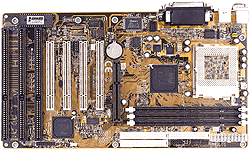Shuttle HOT-683 LX Socket-370 Preview
by Anand Lal Shimpi on January 12, 1999 6:08 PM EST- Posted in
- Motherboards
When the Pentium II was released, Intel did a quick job of releasing a chipset to support their newest processor. In actuality, they didn't do any innovative development for a Pentium II chipset, rather they released a hacked version of their Pentium Pro chipset, the 440FX Natoma, with Pentium II support. Less than 6 months later, Intel announced a real Pentium II chipset, the 440LX, which boasted the industry's first support for the Accelerated Graphics Port (AGP) interface. Unfortunately, for those that invested in LX based motherboards, less than 6 months later, the 440BX came in and took the spotlight off of the LX chipset with it's 100MHz FSB support.
Did all the engineering time and design that went into the implementation of the 440LX chipset go to waste? How about all of those left-over LX chipset parts motherboard manufacturers had after the introduction of the BX chipset? Intel's introduction of the low-cost Socket-370 platform opened the way for the reintroduction of the Intel 440LX chipset, since the new socketed Celerons don't require the 100MHz FSB, the LX chipset is the ideal solution for a low-cost system. Let's see how Shuttle put the resurrected LX chipset to work with their pre-release sample of the HOT-683...
New Anand Tech Report Card Rating 82/C
Do not compare newer ratings to older ones, the newer ratings are much more aggressive
| CPU Interface | Socket-370 |
| Chipset | Intel 440LX |
| L2 Cache | N/A (on-chip) |
| Form Factor | ATX |
| Bus Speeds | 66 / 68 / 75 / 83 |
| Clock Multipliers | 3.0x - 6.0x (Auto Detect) |
| Voltages Supported | 2.0v (Auto Detect) |
| Memory Slots | 3 168pin DIMM Slots |
| Expansion Slots | 1 AGP
Slot 4 PCI Slots (4 Full Length) 3 ISA Slots (1 Shared / 3 Full Length) |
| BIOS | Award BIOS |
The Good
| Reminiscent of older TX based Socket-7 motherboards, Shuttle's ultra-cheap Socket-370 creation starts off with a 4/3/1 (PCI/ISA/AGP) expansion slot configuration that allows for flexibility in peripheral upgrades, the 4/3/1 configuration is by far the most "please all" solution since it tailors to the needs of those that want more PCI and those that want more ISA slots at the same time. Like most other Socket-370 boards, the HOT-683 features 3 DIMM slots and a memory capacity of 768MB, however at the time of testing only 128MB modules were available for use, in either case, the maximum cacheable memory area of the CPU/chipset isn't approached by the maximum installable RAM, meaning that you won't experience a performance penalty for any RAM upgrades on this board. Those days of worrying about the old Socket-7 chipset cacheable memory areas are finally gone. |  |
Without the clumsy slot-1 to worry about, the layout of most newer Socket-370 motherboard should be vastly improved from what we've been used to. Like the Microstar MS-6153, the Shuttle HOT-683 is a perfect example of just that. The ATX power supply connector is properly positioned at the very edge of the motherboard, and the CPU socket is directly in the path of airflow from the ATX power supply to aid in system cooling, just as described in the ATX specification. At the heart of the motherboard is Intel's LX chipset, which keeps the manufacturing costs low, and therefore, the overall cost of your system at an affordable level.
Due to the simplicity of the Celeron line (only one clock multiplier is enabled per chip), the Shuttle HOT-683 features a fully jumperless CPU auto-detect setup. Although the FSB/clockmul can be manually set, by using Shuttle's auto-detect feature, the BIOS will properly report and detect your CPU, something made much easier since all Socket-370 CPU's are made by Intel for now. All of the jumper settings are documented on the motherboard itself, as well as the quick installation guide Shuttle will be providing with the product.
The HOT-683's feature set includes thermal/voltage monitoring systems, and all of the benefits the original LX chipset brought us, at a price that is simply in a class of its own in comparison to what we've been used to, for even a Slot-1 Celeron system.
The stability of the HOT-683 is something to be proud of, Shuttle makes it clear that "low-cost" doesn't mean "low-stability," as their HOT-683 was just as stable as Microstar's MS-6153, and when overclocked, the stability dropped just a few percentage points, however still quite reliable as a product.
The performance of the 440LX chipset on the HOT-683 is a hair away from being as fast as the 440BX on most other Pentium II and Socket-370 boards, the performance difference is not great enough to warrant any sort of complaint. It looks like the premature death of the 440LX chipset has been put in plain black and white with its reintroduction on Socket-370 motherboards.










0 Comments
View All Comments